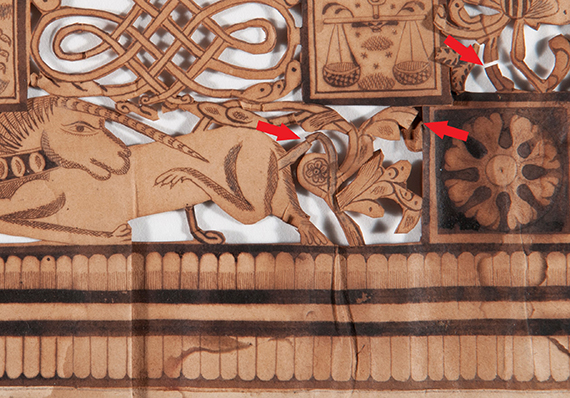Many of the broken or folded pieces of paper cannot be aligned, or unfolded and aligned, without first expanding that area of the papercut. Some of these sections are indicated below.

For these areas to be aligned, every crease and fold in the papercut would have to be opened. Several treatment options are being considered to address this:
• First, conservators can mend and reinforce broken fragments in their current misaligned or folded orientation. This would stabilize the piece, but because the paper and ink will only get more fragile over time, this option might prohibit a future treatment requiring correct alignment of all the pieces. Although the mends would be reversible, the moisture necessary to remove them from the fragile fragments carries a high risk for severely damaging the paper.
• Conservators can also unfold the entire piece to align and straighten all the elements before mending and reinforcing. This would allow the piece to be stabilized with all the elements in the correct orientation. It would also provide the best chance of future treatments, like lining, that may become necessary as the ink and paper continue to deteriorate (albeit at a slower rate now that the object is in climate-controlled storage). This option is also the most invasive, exposing the object to the greatest risk of damage during the treatment itself. Fully unfolding the work would be complicated because it is made up of multiple pieces of paper. The four corner pieces that appear to have been attached after the rest of the papercut was crumpled and compressed would likely need to be removed to allow the papercut to expand, and then reattached after treatment, a major undertaking given the fragility of the paper.
• Lastly, conservators can reinforce only those areas that can be unfolded and aligned. Any breaks that do not align would be left as they are. This would be the least invasive treatment at this time and allow the greatest freedom for any future treatment. It does also leave the object susceptible to the greatest risk of damage going forward.
Weighing these different treatment options in partnership with curatorial colleagues requires balancing the risks, benefits, and goals of the treatment, anticipating how the object will continue to deteriorate well into the future, predicting how the object will be utilized by the Museum, and considering any mitigating factors a museum environment might offer. Most conservation treatments involve this type of thought process. How treatment of this papercut will be completed is still to be decided; let us know what you think about the different options at conservation@mfa.org.
